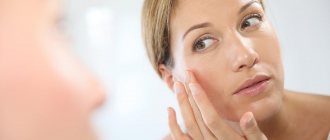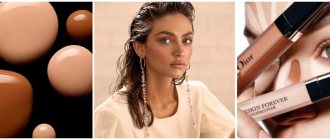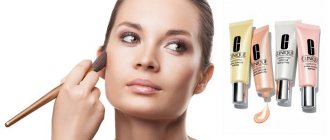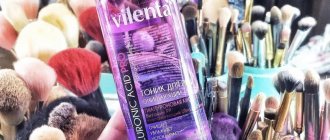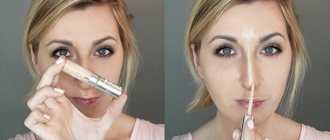Home » Face
Category: Face
Ladies, what is the most important makeup product you have in your makeup bag? For many of us, this is a magical, irreplaceable invention called a corrector. Even on days when we don't sleep, we can fake a good night's rest with a little bit of it here and there. Once you apply concealer to some key areas of your face, your skin will instantly look better without needing coverage elsewhere. If you want to keep your makeup minimal, then concealer is exactly what you need! We are going to give some essential pointers on how to apply concealer correctly and also how you can use it as your base for your makeup.
- Why do you need a face corrector?
- Why do you need a green face concealer?
- Colors of correctors for the face: which one for what
- How to choose a face corrector?
- How to properly apply concealer to your face
- How to use a face corrector pencil: step-by-step photos
- How to use a palette of color correctors for the face: step-by-step instructions with video
- How to use liquid face concealer
- The best color corrector palettes for the face
- The best spot correctors for the face
Why do you need a face corrector?
First, the texture of your concealer is just as important as its shade. Secondly, you will need more than one type of concealer to achieve the right color. The product you use to cover your dark circles is not the same as what you use to cover up your dark spots. The area under your eyes will have some sort of purple color to it, and to combat this means using a concealer that has orange or peach tones to it.
To conceal a blemish or dark spots, use a heavier formula (that matches the shade of your foundation), and if there is redness in the blemish, applying a green concealer will help neutralize that area.
Do you apply foundation or foundation before or after concealer? Remember that if you are going to apply foundation, it is best to apply foundation all over before applying concealer as it helps cover up a lot of imperfections on its own.
Buying tips
A step-by-step photo of how to properly apply concealer to your face will help you understand the secrets of the skill only if you have high-quality cosmetics.
Below is information to help you choose one.
- Look at the expiration date. Expired goods lose their properties and often cause allergies and redness.
- Use testers. Apply a little pigment to your wrist to check color and texture compatibility.
- Buy from trusted places. Nowadays, it is not difficult to stumble upon a fake from an unscrupulous manufacturer. Only a good supplier will help you avoid this trouble.
Makeup is not easy, but very interesting! Many skills come with practice, and therefore we advise you to quickly arm yourself with the necessary tools and head to the mirror. Now you know how to properly use face concealer step by step. Good luck!
Why do you need a green face concealer?
Green is the opposite color of red on the color wheel and is therefore the strongest color for canceling out red. Because of this, green color-correcting concealers are best for neutralizing intense red spots. Most green color correctors are a pastel mint color.
- Use green concealers directly on small red areas such as pimples.
- Green concealers are also good for moderate areas of redness such as mild acne and irritation. For those with fair skin, apply green concealer down the front of the nose, center of the forehead, around the nostrils and along the cheekbones.
- For more diffuse areas of bright redness that cover most of your face, such as sunburn or rosacea, consider using a green-colored primer instead. A tinted foundation will work just like a color correcting concealer but will even out your tone for a flawless foundation application.
What to shade with?
Many people wonder what is the best way to apply concealer to their face. This, like shading, can be done in several ways.
- Some people find it more convenient to use their fingertips without purchasing additional tools.
- Using a brush is a more hygienic method. It can be used to work in more detail on some hard-to-reach areas such as the wings of the nose, or it can be used specifically on problem areas.
- For this procedure, you can use the pointed tip of a sponge . It is recommended to take a damp cosmetic sponge to make the coating more natural. Apply cosmetics using blotting rather than rubbing movements.
- Some products have a special applicator for easy application.
Colors of correctors for the face: which one for what
Here are the main colors you'll find and what they address:
- Green color: redness and broken capillaries
- Blue/lavender: dark circles
- Pink/Peach: Darkness, dullness and blue veins, especially on fair skin
- Yellow: Dull, especially in olive skin tones
- Orange/Red: Darkness on skin tones deeper than medium
There are different rules for under eye circles when it comes to light/medium and dark skin tones. For fair skin, a yellow, peach or purple based corrector will undo the gray tones created when the corrector was used over shadow areas.
On darker skin, use a bright orange or red color first, followed by a neutral or yellow tinted concealer. In any case, apply the concealer with your finger or brush to prevent it from smearing.
Yellow color corrector
Add a layer of yellow to even out your ruddy complexion.
Sometimes green concealers work too well, leaving your skin looking dull and lifeless. By choosing yellow instead, a warm color next to green on the color wheel, you can soften the red discoloration without completely removing all traces.
- Yellow concealers are a good choice for covering mild to moderate diffuse redness.
- Yellow concealers are also great for neutralizing and brightening dark purple and blue marks such as fresh bruises, age spots, sun spots and dark circles under the eyes in some people.
- Many concealers and foundations for lighter skin tones have some degree of yellow pigment for built-in color correction.
Orange color corrector
Use bright orange on darker skin tones. If you have darker skin, orange can be used for different types of discoloration, from acne scars to hyperpigmentation around the lips.
- You can also apply orange all over your face for a glowing effect. When using orange as a full face product, consider using a dusting of orange powder or tinted foundation instead of concealer.
- Orange is also the color of choice for correcting blue tinted under eye circles on medium to dark skin.
- If you have darker skin that has a lot of natural variation in tone, it's best to also use two or more different orange colors for color correction. Use a deeper orange on darker areas of the skin and a paler orange on lighter areas.
- If you have fairer skin, then you may choose to use orange concealer as a bronzer for contouring instead of color correction. Orange is generally too bold to work as a color corrector on fair skin, but you can brighten your under-eye area with a subtle salmon color corrector.
How to choose a face corrector?
Understand how color correctors and concealers work.
Color-correcting concealers help disguise skin discoloration, giving problem areas a more neutral tone. When choosing concealers, understanding color theory will be helpful.
- Complementary colors are colors that are completely opposite of each other on the color wheel. Below are the basic complementary color pairs you'll use for color correction: red with green, yellow with violet, and blue with orange.
- For most types of color correction, makeup in one color will cancel out the bleaching of its complement.
- A completely opposite color can also sometimes appear lifeless and unnatural. In these cases, you should use color next to the bleach addition.
- Most corrective concealers come in one shade. The exceptions are orange and beige. To do this, choose deeper shades if you have a darker skin tone and pastel shades if you have a lighter skin tone.
- Regular skin tone corrector is usually used on top of color correctors.
Conclusion
Before choosing a concealer for your face, you need to determine your skin type and shade and the areas where it will be applied. People with dry, sensitive skin are better off trying to use liquid and cream concealers, which not only mask imperfections, but also moisturize and nourish the skin. For users with oily skin, dry concealers with a matte finish are suitable. They ensure the stability of makeup and specific corrections.
People with normal skin can use concealers of any consistency. The important thing here is to decide what tasks they should perform. It is also important that the tools are convenient to use. If your skin is already aging, you should not buy low-quality and untested products. They will roll down on the face, get into wrinkles and make them more noticeable. In this case, their use makes no sense.
How to properly apply concealer to your face
Here are a bunch of tips and hacks that will come in handy when you're applying concealer. Also, take a look at how to use concealer to enhance your makeup look. Let's get a look!
- First the foundation and then the concealer. If you are using foundation, apply it first so you don't have to cover up much. Plus, if you apply concealer first, you'll remove most of it while applying foundation.
- Never skimp on quality when it comes to concealer. Invest in a good product that will apply smoother and be less likely to dry out and bake.
- To prevent your eyeshadow from falling out and fading, use your concealer to set the eyeshadow first.
- Use a peach tinted concealer for blue or purple circles under the eyes. Use a yellow tinted concealer to even out your skin tone. And use green corrector for red spots.
- If you want to prevent your concealer from creasing around your eyes, blot the area with a tissue after applying to prevent it from settling in the creases around your eyes.
- You can also use concealer as a base to brighten your lipstick shade.
- To prevent your lip color from smearing, line your lips with concealer using the fine tip of the brush. Your lips will also look extra defined after this one simple step!
How to disguise bruises and dark circles under the eyes
Actions:
- When bruises are very noticeable under the eyes, it is necessary to use a corrector in a pink, yellow or orange shade. A corrector 1 shade lighter than the skin is applied on top, or this area is immediately treated with a suitable foundation.
- In order to camouflage dark circles, you need to use a corrector of the required color. A pinkish tint is suitable for fair skin, peach for medium skin tones, and orange for dark skin tones.
- You need to apply a corrector of a certain color in the same way as a concealer or a standard nude.
How to use a face corrector pencil: step-by-step photos
Step 1: Prepare your skin
Always start with a clean face! Cleanse, exfoliate and moisturize your skin with a facial moisturizer, apply some foundation, and then move on to makeup.
Step 2: Conceal Dark Circles Around Your Eyes
How to apply concealer under the eyes? Use a concealer that is no more than two shades lighter than your natural skin tone. What you should do is brighten the area under the eye by creating two inverted triangles and blending them using a brush or beauty sponge.
Step 3: Conceal the redness around your nose
If you have any redness or discoloration around your nose, the best way to apply concealer is to take a small amount and mix it thoroughly.
Step 4: Conceal Dark Spots
If you have acne scars or blemishes, layering on tons of foundation is not the solution. Use a small concealer brush and apply the product to blemishes over problem areas, blending it into the skin.
Step 5. Secure the corrector
It is best to set the concealer using powder as this will prevent the product from shifting. Take some powder onto a sponge and gently pat it into the areas where you applied your concealer. For the rest of your face, use a brush and gently apply powder everywhere for a natural look.
This is what happened
What it is
This is a cosmetic product that can visually hide major imperfections.
By skillfully using different halftones, you can correct the oval: straighten the nose, emphasize the cheekbones, make the lips and eyes more expressive. In the first third of the last century, a similar product to the current product was used to disguise unsightly birthmarks in open areas, burns, and scars. The thickly applied texture perfectly hides freckles, which was also actively used during periods of fashion for smooth and clean skin.
The founder of the production of the drug specifically for decorative and cosmetic purposes was the Max Factor company in 1954. Her creamy paste created a sensation at one time and instantly became a regular fixture in the makeup bag of any Hollywood or society lady.
How to use a palette of color correctors for the face: step-by-step instructions with video
Concealing dark circles under the eyes with concealer
Apply peach or orange to dark circles under your eyes.
Concealers in this color family are a muted combination of orange, red, and yellow. Because of this, one concealer can cancel out the blues, greens, and purples often found in the dark under eye circles of people with fair to medium skin.
- In general, salmon works best on pale skin, while peach works best on olive and tanned skin.
- You may have to experiment a bit to find the exact shade that works best for your skin.
- Peach can also work very well on pale skin to correct brown spots and age spots.
- These shades are also good as an all-around balancing brightener for olive skin.
Even out skin tone with corrector
Apply lavender concealer to balance out yellow tones or yellow skin. Purple is a complement to yellow, so purple concealers neutralize warm yellow tones. The vast majority of purple concealers are pastel lavender in color.
- You can use lavender to cover up old bruises and age spots.
- Like orange and yellow, lavender can also be used anywhere. When using a color corrector in this manner, consider a tinted primer as an alternative.
- If your natural, healthy tone is yellow, don't feel the need to “fix” it. Skin that simply has a warm undertone appears radiant on its own.
Removing pigment spots using a corrector
Apply blue to cover up orange hyperpigmentation. While orange discoloration is uncommon, the best way to neutralize it is with its complement, which is blue. Most blue concealers tend to work best on fair to medium skin tones.
- These concealers are best for balancing warm tones that are dark and intense, such as sunspots.
- These concealers are also a good choice if you've gone a little overboard with DIY application.
- If the discoloration is all over your face, try using a blue foundation shade instead of a concealer.
How to use liquid face concealer
You can use your concealer as a base thanks to its versatility! So if you forgot to stock up on foundation, don't panic! Here's how to apply concealer and use it to create your base.
- Choose a formula you like, whether it's a cream or liquid concealer. Make sure you have two shades - one that matches your skin tone and one to brighten key areas of your face.
- Use a stippling brush because these brushes don't pick up too much product and you don't want your face to look made up and sticking out.
- Dip it into your concealer and start applying from under your eye area. Now you conceal and apply your foundation at the same time.
- Make sure you have an even amount of product and color all over your face and blend it thoroughly.
- Once you are done with this, use a little powder and use a brush to apply it to all the desired areas
- Now that your base is ready, you can use additional products like blush or bronzer and finish the look!
Contouring Brushes
What kind of contouring brush should be and in what cases is it especially useful? Let's figure it out!
© nyxcosmetics
1
A soft fluffy brush (the kind usually used when applying blush) will come in handy when working on the sub-cheekbone area. Place a little bronzer or powder sculpting product on your brush, apply lightly to the skin and blend well.
© Makeup.ru
2
Cream or liquid textures are more convenient to distribute with a sponge, but in some cases a kabuki brush with a straight cut can be an excellent alternative. Apply the product using a tapping motion and do not forget to blend it properly.
3
Dry highlighter is most conveniently applied with a wide fan brush, which will ensure even application and a translucent layer.
© maybelline
© Makeup.ru
4
You can also distribute cream sculpting products using a flat synthetic bristle eyeshadow brush: this will ensure the most precise application. It is most convenient to “use” an eyeshadow brush with a slightly pointed tip.
© Makeup.ru
The best color corrector palettes for the face
Tarte Wipeout Color-Correcting Palette
This versatile palette from Tarte Cosmetics is the perfect choice for beginners. You can use its six shades to combat discoloration and contouring, as well as balance and brighten your skin tone. Simply apply the cream wherever you need it using a stiff brush until it blends into your skin.
Color correcting palette Stila Correct & Perfect B
This stunning palette from Stila is sure to win your heart with the way it looks and performs! It consists of five velvety-smooth cream concealers and two tinted setting powders. Light creams offer buildable coverage, while powders allow you to customize your coverage. Their rich formula contains vitamins A, C, E and Arclay Youth Revival mineral complex to reduce the appearance of pores and fine lines.
pros
- Easy
- Doesn't make your skin oily
- Waterproof
- Easy to use
MAKEOVER Pro Conceal And Correct Palette, shade F2302 (creative concealer)
Makeup artists swear by this professional color correcting palette from MAC, and yes, it's one of the best out there! Each palette consists of four concealers and two shade correctors in the middle depth of the color spectrum. Its formula is enriched with antioxidants and is suitable for all skin types. You can use the colors either individually or mix them to match your skin tone. She covers everything from spots to moles to tattoos! This palette comes in four different shade options: light, medium, medium-deep, and dark.
pros
- Doesn't roll down
- Many colors
- Dermatologist tested
- Non-acnegenic
Nyx color correction palette
This cult classic from NYX is one of the best color correcting palettes out there. It contains six creamy shades that can be mixed to create the perfect shade for you. Its formula is super-light, glides on easily and leaves your skin looking smooth, soft and supple. If you're new to color correction, this is a product you need to try!
pros
- Pigmented shades
- Easy
- Suitable for all skin types
- Accessible
Limoni Face corrector set Skin Perfect corrector 5 cells, shade 01
Want an Insta-perfect face? This color correcting kit from Maybelline corrects, conceals and highlights all in one palette. It's incredibly easy to use and a must-try for beginners! It works well on all skin types, and if affordability is a factor for you, it does a good job at a very decent price.
pros
- Easy to use
- Mixes easily
- Inexpensive
Types of concealers
All concealers are classified by shape, color and area of use. They are in form like this:
- Stick
. Looks like an automatic lipstick. Similar products are available in two palettes: light and dark. This allows you to simultaneously hide skin imperfections and beautifully highlight depressions and protrusions. Lumene Beauty Base Cover Stick, Debby Concealer Solution Stick;
Debby Concealer Solution Stick - Palette
. This is a professional cream concealer for correcting skin imperfections. The palette can be almost anything, but unlike sticks, it also contains additional shades. Green, red, yellow and others. The most famous "representative" of MAC Professional MakeUp;
MAC Professional MakeUp - Pencil
. These concealers are the most convenient to use, so they are often recommended for beginner makeup artists. Most often they are produced in two color options: dark and light. These are Bobbi Brown's Face Touch Up Stick, Zuii Organic Concealer Pencil;
Zuii Organic Concealer Pencil - Liquid concealer
. It looks very similar to a concealer and is applied to the skin with a brush. Convenient for treating large areas of skin: bruises, redness, etc. Products include Catrice Liquid Camouflage High Coverage Concealer, MAC Pro Longwear Concealer (MAC), Nyx HD Photogenic and others.
MAC Pro Longwear Concealer
According to the area of use, concealers are also reflective and corrective . The latter are traditional, they are used in all makeup techniques and can replace bronzer, blush and highlighter. A reflective concealer contains tiny mineral particles that reflect the light falling on the skin.
Anti-acne concealer
The best spot correctors for the face
L'Oréal Paris True Match Concealer
There is a perfect match for every skin tone due to the range of shades. It can be used sparingly for very light application or built up for more coverage if desired. I like to use neutral concealer colors to correct purple and blue circles and cool concealer to set and fade spots around the nose.
Neutrogena Perfector
This is a great alternative to its more expensive counterparts, such as the YSL Touche Éclat. It's a beautiful light texture that instantly covers dark circles and brightens under eyes. You can also use it under your eyeshadow to set it. Just make sure you use it sparingly.
L'Oreal Paris Alliance Perfect True Match Cream Concealer, shade 3-5N, natural beige
This is my favorite because not only does it provide great lighting, but it is also very easy to use. The pencil makes it easy to place concealer just where you need it. Plus, the range of colors is incredibly natural and wearable.
Errors during use
It is very difficult to achieve an ideal result the first (and sometimes even the second and third) time. Even experienced makeup artists sometimes encounter small mistakes. The most common of them are collected in the list below.
- Wrong selection of cosmetics. A discrepancy between the skin type and the texture of the product can greatly affect the quality of the make-up and aggravate all imperfections.
- Wrong choice of shades.
- Insufficient shading. If you don't blend the cosmetic product to the right extent, it will look unnatural and awkward. At the end of the makeup process, make sure that all the brown streaks create a shadow effect, and the green, lilac and pink strokes are well hidden by the tone.
